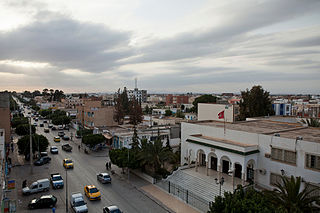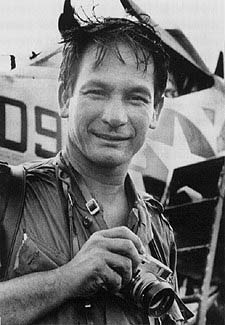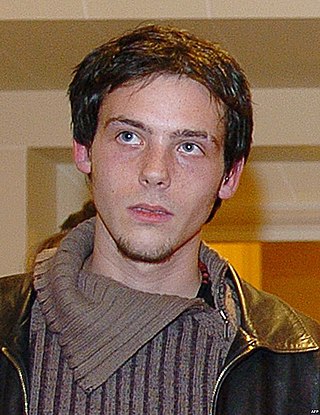External links
- Lucas Dolega: Photoreporter website
- Photographs by Lucas Dolega, European Pressphoto Agency
- Michel Puech, "Tunis: le photographe Lucas Dolega de l'agence EPA est décédé". Mediapart, January 2011. (in French)
Lucas Dolega | |
|---|---|
| Born | Loucas von Zabiensky-Mebrouk 19 August 1978 |
| Died | 17 January 2011 (aged 32) |
| Cause of death | Tear gas canister |
| Nationality | French and German |
| Other names | Lucas Mebrouk Dolega |
| Occupation | Photojournalist |
| Years active | 2006–2011 |
| Employer | European Pressphoto Agency |
Lucas Dolega (19 August 1978 – 17 January 2011), born Loucas von Zabiensky-Mebrouk and also called Lucas Mebrouk Dolega, was a French/German photojournalist. He was reportedly killed by Tunisian police while he was photographing a protest in Tunis. As reported in The Guardian (UK), Dolega was the first journalist killed during the 2010-2011 Tunisian protests, according to Reporters Without Borders. He was also the first journalist to die while on assignment during the Arab Spring uprisings. [1] [2] [3]
He was fatally injured on the same day that Zine El Abidine Ben Ali fled Tunisia for exile.
Dolega was born in Paris on 19 August 1978 to a German mother and a French father, a journalist and a doctor respectively. He grew up in Paris, before moving to Tangier in Morocco. He had French and German citizenship, and started work as a photographer for European Pressphoto Agency in April 2006. [4] [5] He was based in Paris, covered a variety of stories in Europe, and in 2008 photographed the Congo. [6]
Dolega was 32 years old when he died. [7]
On 14 January 2011, the day after Dolega arrived in Tunis, and at the end of a demonstration on Avenue Bourguiba, he was within a group of journalists at the corner of rue Gandhi and rue de Marseille. He was hit in the head by a tear gas canister, about 20 cm long and 5 cm diameter, reportedly fired by police at short range and horizontally toward a group of photographers. He was taken first to a clinic and then to Tunis Rabta Neurologic Hospital where he was operated on but died on 17 January. [5] [8] [9] [10] Fellow photographer and friend Olivier Laban-Mattei brought Dolega's corpse back to France. [11]
Dolega was the first of a number of journalists who were killed over the course of the Arab Spring uprisings in 2011. He was killed while on assignment. He is among a group of photojournalists who were killed while covering protests, such as Hiro Muramoto, cameraman and journalist shot by a soldier in Bangkok, 2010; or Kenji Nagai, a photojournalist who was shot by a soldier in Rangoon, 2007.
The Lucas Dolega Award (Prix Lucas Dolega) was established in 2011 to honor photojournalists who have reported under difficult circumstances. [12]
Lucas Dolega is mentioned in the poem "A Love Letter from Emilie Blachère to Rémi Ochlik", written by Paris Match journalist Emilie Blachère on the occasion of the first anniversary of Rémi Ochlik's death. [13] She writes: "My angel, give Lucas a kiss for me. Take care of yourself. Take care of us." [13] After she read the poem on BBC Radio 4's Broadcasting House news program, radio host Paddy O'Connell broke down emotionally and could not bring himself to continue the news broadcast for around 12 seconds. [14] Rémi Ochlik was a friend and colleague of Lucas Dolega, he was with Dolega when Dolega died, and he worked on establishing an award in Dolega's honor after his friend's death. [11]
Censorship in Tunisia has been an issue since the country gained independence in 1956. Though considered relatively mild under President Habib Bourguiba (1957–1987), censorship and other forms of repression became common under his successor, President Zine El Abidine Ben Ali. Ben Ali was listed as one of the "10 Worst Enemies of the Press" by the Committee to Protect Journalists starting in 1998. Reporters Without Borders named Ben Ali as a leading "Predator of Press Freedom". However, the Tunisia Monitoring Group reports that the situation with respect to censorship has improved dramatically since the overthrow of Ben Ali in early 2011.

Guy Patrick O'Connell is an English television and radio presenter. He presents BBC Radio 4's Broadcasting House programme each Sunday morning. He is also an occasional presenter of the PM programme. O'Connell is a Fellow of the Royal Society of Arts.

Sidi Bouzid, sometimes called Sidi Bou Zid or Sīdī Bū Zayd, is a city in Tunisia and is the capital of Sidi Bouzid Governorate in the centre of the country. Following the suicide of Mohamed Bouazizi in Sidi Bouzid, it was the site of the first clashes of the Tunisian Revolution and a catalyst for other protests in the region, often known as the Arab Spring.

Henri Huet was a French war photographer, noted for his work covering the Vietnam War for the Associated Press (AP).

Kenji Nagai was a Japanese photojournalist who took many assignments to conflict zones and dangerous areas around the world.

European Pressphoto Agency B.V. is an international news and photo agency.
Hiro Muramoto was a Japanese TV cameraman and journalist, who worked for the Australian Broadcasting Corporation in Tokyo in the 1990s, and who reported for Reuters television for more than 15 years. Muramoto was based in Reuters' Tokyo bureau.

The Tunisian revolution, also called the Jasmine Revolution and Tunisian Revolution of Dignity, was an intensive 28-day campaign of civil resistance. It included a series of street demonstrations which took place in Tunisia, and led to the ousting of longtime dictator Zine El Abidine Ben Ali in January 2011. It eventually led to a thorough democratization of the country and to free and democratic elections, which had led to people believing it was the only successful movement in the Arab Spring.
Ahmed Mohamed Mahmoud was an Egyptian print reporter for the newspaper Al Tawuun, which is distributed by state-run Al-Ahram. He was shot by a sniper on the balcony of his office while filming the outbreak between Egyptian protestors and security forces on January 28, 2011 during the 2011 Egyptian Revolution. He died six days later in a local Cairo hospital, and he was the first journalist to die in Egypt during its Arab Spring uprising.
Events from the year 2012 in France:

Marie Catherine Colvin was an American journalist who worked as a foreign affairs correspondent for the British newspaper The Sunday Times from 1985 until her death. She was one of the most prominent war correspondents of her generation, widely recognized for her extensive coverage on the frontlines of various conflicts across the globe. On February 22, 2012, while she was covering the siege of Homs alongside the French photojournalist Rémi Ochlik, the pair were killed in a targeted attack made by Syrian government forces.

Rémi Ochlik was a French photojournalist who was known for his photographs of war and conflict in Haiti and the Arab Spring revolutions. Ochlik died in the February 2012 bombardment of Homs during the 2011–2012 Syrian uprising along with veteran war correspondent Marie Colvin.

Paul Conroy is a British freelance photographer and filmmaker who works in the British media. A former soldier with the Royal Artillery between 1980 and 1987, he has since worked extensively as a journalist in combat zones, producing footage from conflicts in the Balkans, the Middle East, and Libya. In 2011, he was shortlisted for the PRX Bayeux TV report along with Marie Colvin, a war correspondent with The Sunday Times.

Majid Saeedi is an Iranian documentary photographer.
Ali Mahmoud Othman is a Syrian citizen journalist and activist from Homs. He is nicknamed the "Eyes of Baba Amr" and "Jeddo" (Grandfather).
Mikhael Subotzky is a South African artist based in Johannesburg. His installation, film, video and photographic work have been exhibited widely in museums and galleries, and received awards including the KLM Paul Huf Award, W. Eugene Smith Grant, Oskar Barnack Award and the Discovery Award at Rencontres d'Arles. He has published the books Beaufort West (2008), Retinal Shift (2012) and, with Patrick Waterhouse, Ponte City (2014). Subotzky is a member of Magnum Photos.

On 18 March 2015, two militants attacked the Bardo National Museum in the Tunisian capital city of Tunis, and took hostages. Twenty-one people, mostly European tourists, were killed at the scene, and an additional victim died ten days later. Around fifty others were injured. The two gunmen, Tunisian citizens Yassine Labidi and Saber Khachnaoui, were killed by police. Police treated the event as a terrorist attack.
Jean Revillard was a Swiss photojournalist and winner of two World Press Photo awards in 2008 and 2009.
Francis Apesteguy was a French independent reporter-photographer. He was known as a paparazzo, working for Sipa Press, Daniel Angeli, and Gamma.
Fatima Al-Zahra'a Shbair is a Palestinian photojournalist based in Gaza City, Palestine. She won a Prix de la Ville de Perpignan Rémi Ochlik award by Visa pour l'image in 2021 and a World Press Photo award in 2022.